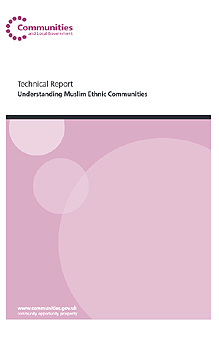
Author: Change Institute
Genre: England
Publisher: Communities & Local Government (CLG)
Release Date: 17 April 2009
Pages: 32
Source: https://webarchive.nationalarchives.gov.uk/20120920001411/http://www.communities.gov.uk/documents/communities/pdf/1203896.pdf
The government department ‘Communities and Local Government’ commissioned the UK consultancy Change Institute in 2008 to prepare a series of reports “to enhance its understanding and knowledge of the diverse Muslim ethnic populations in England”. Change Institute has now published its findings, with twelve reports placed in the public domain: on communities originating from Afghanistan, Algeria, Bangladesh, Egypt, India, Iran, Morocco, Nigeria, Pakistan, Saudi Arabia, Somalia and Turkey. A further report, on Iraqis, is presumably forthcoming.
The 2001 Census’s question on religion provided a basis for demographic and socio-economic data on the main ethnic categories. While there was some provision for respondents to provide a ‘fill in’ answer if the main categories did not apply, this was not well taken up. It is disappointing that the Change Institute has not gone beyond the 2001 Census in seeking to provide better population estimates of the communities it investigated.
For example, its report ‘The Afghan Muslim Community in Britain’ merely indicates, “There are significant variations in the estimates of the Afghan population in England. The 2001 census estimated the total number of Afghans in the England, by country of birth, as being 14,481, with 73 per cent (10,832) of these residing in London. The only other region with a population in excess of 500 (according to the 2001 census) was Birmingham. … However, the current figure of Afghans in England is likely to be considerably higher, primarily due to the large number of asylum seekers and refugees that have entered the country since 2001.”
Anecdotal sources suggest that the London Borough of Harrow alone has an estimated 10,000 Afghanis!
The reports are better value for money in their qualitative sections, and some of the interview findings point to the realities of life in modern Britain. Thus the section on Pakistanis notes, “the use of the term integration is particularly resented, as it is felt to imply a one sided focus on minority communities, as opposed to being promoted as a two way process. There is also a widespread view that no matter how much minorities try, the majority community will never accept them as truly British. Some are also very critical about the low levels of awareness and lack of interest in the host community about minority communities and cultures. There is a high level of anger about the perceived increase in Islamophobia in British society and the stereotyping of all Muslims as potential terrorists or terrorist sympathisers. This makes people feel that their loyalty and British identity is being questioned. Most people in the community believe that, like mainstream society, the majority of Pakistanis view acts of terrorism as a serious crime and hence the exploitation of terms to link all Muslims with terrorism is a very serious issue.”
Similarly the account of the Somali community’s problems observes “there are said to be high levels of stress and mental health related illness in the community, the likely causes of which are lack of access to employment, racial harassment and isolation. The community also has to cope with the traumas resulting from many years of war and life in refugee camps, forced migration and family breakdowns. All these are believed to lead to a range of hidden ‘health and well-being’ issues, which are not being recognised or addressed by health and social welfare providers… Somali born migrants have the lowest employment rate and lowest levels of education of all immigrants in the UK.”
Change Institute settles for a population total of around 50,000 Somalis. Anecdotal information suggest that there may be between twice to four times that number in the country! The lack of better statistical data would result in a serious under-estimation in planning the allocation of public resources.
The Change Institute reports capture for posterity some of the political machinations of our times, ” in more recent years it [the Muslim Council of Britain] had become the focus of controversy for its linkages to Islamist movements like the Muslim Brotherhood and the Jama`at-i Islami. Consequently, the government distanced itself from the MCB and started a process of consulting, funding and endorsing other Muslim organisations. However, this led to the perception that the government was promoting sectarianism as well as making the formation of a vigorous, broad front against violent extremism more difficult, with some Muslim groups withholding active support…”. Change Institute ought to have added that the key instigator of this fragmentation of Muslim civil society has been its paymaster, CLG. Nonetheless, these are welcome studies, and the CLG is to be commended for broadening our understanding of the truly diverse, multi-ethnic and multicultural nature of modern Britain.
